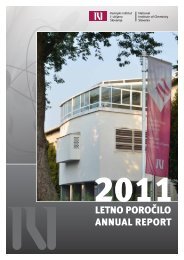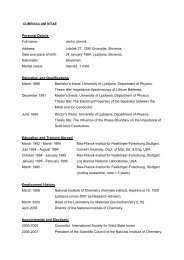Letno poročilo 2005
Letno poročilo 2005
Letno poročilo 2005
Create successful ePaper yourself
Turn your PDF publications into a flip-book with our unique Google optimized e-Paper software.
SLIKA 3:<br />
Vpogled med dve G-kvartetni ravnini, ki sestavljata<br />
G-kvadrupleksno strukturo (na levi). V sredi{~u<br />
vsakega G-kvarteta so prostorsko blizu {tirje O6<br />
karbonilni kisikovi atomi (na levi sliki ozna~eni z<br />
rde~imi kroglicami), katerih nevezni elektronski pari<br />
sodelujejo pri koordinaciji kationov, ki so nujno<br />
potrebni za nastanek G-kvadrupleksne strukture. V<br />
konkretnem primeru je amonijev ion koordiniran z<br />
osmimi O6 karbonilnimi kisikovimi atomi, ki pripadajo<br />
dvema G.kvartetoma. Kationi znotraj tak{nih struktur<br />
ne mirujejo, ampak se izmenjujejo preko odprtin v<br />
G-kvartetnih ravninah. Slika je del {tudije, kjer so P.<br />
[ket, M. ^rnugelj in J. Plavec pokazali, da se znotraj<br />
dimernega G-kvadrupleksa, ki ga tvori oligo-<br />
nukleotidno zaporedje bogato z gvanini d(G 3 T 4 G 4 ),<br />
nahajata dve vezavni mesti za katione. V nadaljevanju<br />
so uspeli dokazati obliko G-kvadrupleksa d(G T G ) ,<br />
3 4 4 2<br />
ki vsebuje K + in 15 + NH ion in predstavlja vmesno<br />
4<br />
stanje v prehodu iz dvo-15 + + NH v dvo-K obliko.<br />
4<br />
Korelacijski signali v ROESY spektru med amonijevimi<br />
ioni in imino protoni gvaninov, ki je prikazan na desni<br />
so dali informacijo o polo`aju amonijevega iona<br />
znotraj te strukture. Rezultati te {tudije so bili<br />
objavljeni v ~lanku z naslovom “Identification of mixed<br />
di-cation forms of G-quadruplex in solution” v reviji<br />
Nucleic Acids Res. (<strong>2005</strong>, 33, 3691-3697).<br />
Nacionalni center za NMR spektroskopijo visoke lo~ljivosti - lokacija KI<br />
National Centre for High Resolution NMR Spectroscopy - Location NIC<br />
FIGURE 3:<br />
Detailed view into the structure of a G-quadruplex<br />
showing two G-quartet planes (on the left side). There<br />
are four O6 carbonyl oxygen atoms (marked as red<br />
balls) in the middle of each G-quartet, which are involved<br />
in coordination with cations that are essential<br />
for the formation of G-quadruplex structures. Ammonium<br />
ion in the figure is coordinated with eight<br />
O6 carbonyl oxygen atoms belonging to two neighbouring<br />
G-quartet planes. Cations found inside Gquadruplex<br />
structures are undergoing fast and complex<br />
motion through the opening in each G-quartet<br />
plane. Figure is a part of a study in which P. [ket, M.<br />
^rnugelj and J. Plavec have shown that dimeric Gquadruplex<br />
structure adopted by guanine rich se-<br />
quence d(G 3 T 4 G 4 ) exhibits two cation binding sites.<br />
Furthermore, they experimentally demonstrated the<br />
existence of the mixed form of d(G T G ) containing<br />
3 4 4 2<br />
one K + and one 15 + NH ion inside the G-quadruplex<br />
4<br />
core that represents intermediate in the conversion<br />
of di-15 + + NH into di-K form. Cross-peaks in ROESY<br />
4<br />
spectrum between ammonium ions and neighbour-<br />
ing guanine imino protons shown on the right were<br />
used to localize ammonium ions inside the mixed dication<br />
structure. The results of the study were published<br />
in the manuscript entitled “Identification of<br />
mixed di-cation forms of G-quadruplex in solution”<br />
in Nucleic Acids Res. (<strong>2005</strong>, 33, 3691-3697).<br />
171







